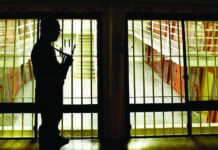
This year they’re facing greater risks due to COVID-19-induced manpower shortages
by T. William Wallin
The 77,758-acre Kincade Fire last October was Sonoma County’s largest fire in history and Edward Lopez was on the ground fighting to keep it contained. A few months earlier he was on the frontline battling Mendocino County’s Usal Fire for five days. Lopez, 27, wasn’t a local firefighter or an employee with CAL FIRE – he was incarcerated at the Eel River Conservation Camp in Humboldt County.
Most Californians are aware of the state’s dangerous wildfire season and the heroic bravery of CAL FIRE staff. Many more are unaware that these fires would cease to be contained and countless lives might be lost without the help of California’s incarcerated firefighters, like Lopez.
These men and women fighting fires alongside local, state and federal firefighters save California 3 million hours in emergency response work and an additional 7 million hours in community service, according to the California Department of Corrections and Rehabilitation (CDCR). This incarcerated labor also saves the state taxpayers $100 million yearly, while incarcerated firefighters only earn, at most, $5.12 per day.
Lopez, who was a juvenile tried as an adult in 2010, spent the last 10 months of his nine-and-a-half-year sentence at Eel River. He fought nearly every Northern California fire last season, as well as fires down south, from April 2019 to February of this year. Lopez paroled right before COVID-19 swept across the planet in a global pandemic, causing countries to enforce shelter-in-place orders.
“Even when COVID shut everything down, those at fire camp are still working,” Lopez said. “We are an essential worker. We are always working.”

The COVID crisis has forced changes in the incarcerated firefighter program. CDCR stated in an email they are actively educating Conservation Camp staff and the incarcerated population on steps they can take to protect themselves from COVID-19, such as proper hand washing and physical distancing.
They also said transfers into conservation camps have been limited and incarcerated individuals who have finished their training are isolated from the general public for 14 days and screened for COVID-19 prior to being transferred.
As of June 5, there were 2,358 CDCR incarcerated individuals with active cases of COVID-19, 232 CDCR or CCHCS (California Correctional Health Care Services) employee cases and 12 incarcerated individual deaths. However, according to the CDCR, there are currently no confirmed COVID-19 cases among incarcerated firefighters. Lopez said that when the fire crew wasn’t fighting fires, they were building bridges, working in state parks and working alongside Caltrans. While incarcerated at Eel River, he said he took full advantage of the training skills offered and was deeply humbled due to the demands of the job.
“A lot of these small communities throughout the state cannot be functional without incarcerated firefighters because you have roads and bridges and we are the ones who do all the work to them to prevent fires,” Lopez said. “Without us, it would be a slow process. We are helping communities.”
This year’s Humboldt County Civil Grand Jury agrees with Lopez. Their recent report, “Angels in Orange,” details the county’s two state conservation camps, Eel River and High Rock, integral in providing important firefighting forces during fire season and community service during off-season. The report findings state both camps were well managed and maintained, and that the jury was “impressed with the positive aspects of rehabilitation provided by the camps as well as the service the camps provide to the communities.”

The jury also concluded that the rehabilitative functions of the fire camps are priceless, stating, “Their mission includes improving safety and quality of life to state residents while providing inmates with a rehabilitative environment to develop the skills and discipline to become successful members of society upon release.”
There are 42 CDCR Conservation Camps in 27 counties throughout California. As of June 5, there are 3,367 incarcerated individuals at the camps and 2,089 of them are incarcerated firefighters, according to the CDCR.
The Civil Grand Jury report states that once an incarcerated individual meets the security risk level to qualify for service, they can volunteer for fire camp. This means they must have the lowest classification for incarcerated individuals based on their sustained good behavior while in prison, have five years or less remaining on their sentence, and have not been convicted of rape, arson, escape or sex offenses.
After the prospective trainee passes a medical evaluation and two-week physical fitness program, they are then transferred for a six-to-seven-week wildfire training by CAL FIRE instructors. Once they pass this training, they are assigned to a fire crew.
Lopez said he made it through the training with ease but it was the first fire he was assigned to that revealed the magnitude of the job.
“Until you are actually doing the work, then you know the intensity,” Lopez said. “Just to understand how serious it is, people have died in the past. At first, you’re nervous and that stays with you. It’s dangerous because you don’t know what to expect. The unknown is always there.”

The Civil Grand Jury report pointed out some problems in the conservation camps. They found shortages in eligible incarcerated volunteers in the two camps due to changes in sentencing and the realignment of incarcerated individuals as mandated by AB109, Propositions 47 and 57, and the Inmate Housing Score guidelines, which is essentially a classification system that identifies incarcerated individuals who may volunteer for fire camp.
Eel River Conservation Camp currently houses only 71 incarcerated individuals and High Rock houses 68. The former is able to house 132 incarcerated individuals and the latter 110.
“Failure to keep these camps fully staffed will result in fewer 16-person hand crews to fight fires, perform fuel reduction activities, and provide other conservation and community services,” the Civil Grand Jury report states.
Lopez said they would fight fires with four crews but in the past, it used to be five. Having one less crew strained the rest of the firefighters, and Lopez said that after fighting one particular fire they were only allotted a two-hour break before having to rush to another.
“They overwork us and we feel like we get worked hard because our assignment needs to be done in a certain amount of time,” Lopez said. “We have to work with half the people. But at that moment houses [and lives] are in danger.”

Because the Humboldt County Correctional Facility (HCCF) is often near or over capacity, the Civil Grand Jury recommends CDCR and Humboldt County Sheriff’s Office build a partnership that would allow qualified incarcerated individuals to participate in shorter work assignments that do not require extensive training at either Eel River or High Rock. Currently, there are not enough qualified incarcerated individuals in the fire crews at Eel River or High Rock.
The Humboldt County Sheriff’s Office stated they would not reply to any questions regarding the grand jury report until their official 90-day response window is closed on Aug. 24. However, Aaron Francis, an information officer for the CDCR, said his agency has contracts with 11 counties to receive eligible incarcerated individuals for CDCR Conservation Camps, although Humboldt County is not one of them. Francis stated that there are 121 county-incarcerated individuals participating in the Conservation Camp Program.
“Inmates continue to complete community service projects when not fighting fires, which include clearing brush and fallen trees, maintaining parks and reforestation,” Francis said. “Currently, individual projects are being completed on a case-by-case basis after review and approval by the camp captain to ensure health and safety guidance to address COVID-19 can be followed.”
COVID-19 has also put a strain on the Conservation Camps. Francis said due to the economic impact of the virus, Gov. Newsom’s 2020-21 May Revision budget proposal to the Legislature proposes the consolidation of eight camps under the Conservation Camp Program that are currently not at capacity.
When asked if Eel River or High Rock were in jeopardy of closing or consolidating due to being under capacity, Francis replied, “We are working closely with CAL FIRE to identify the most efficient use of resources while maintaining an adequate fire response and community involvement.”
Ventura Training Center offers hope to formerly incarcerated firefighters
One of the most important mentions in the Civil Grand Jury report is the three paragraphs regarding employment after incarceration from the Conservation Camps. The report acknowledges the restrictions on those convicted of felonies from being certified as an Emergency Medical Technician (EMT), which is required by most fire departments. Local EMT authority has the power to waive these restrictions, but rarely do.
So, arguably, after risking your life working at a Conservation Camp, the report states, “It is not possible for former inmates who were trained and functioned as firefighters to be employed in municipal fire agencies.”
These controversies are now being challenged by the non-profit organization known as the Anti-Recidivism Coalition (ARC). ARC’s mission is to empower formerly and currently incarcerated people to thrive by providing a support network of services and opportunities to advocate for policy change.
CDCR, in partnership with CAL FIRE, California Conservation Corps (CCC) and ARC, has recently created a first-of-its-kind firefighter training program for formerly incarcerated firefighters called the Ventura Training Center (VTC). Lopez is currently the newest member to the program as of this past June and is officially on the path towards a CAL FIRE career. He was proudly recommended by Eel River when he applied to VTC.
Michelle Garcia is the VTC programs coordinator for ARC and has been at the training center since it began 22 months ago. She indicated her position mainly consists of playing a supportive role that in realty is more than that.

Garcia coordinates with life coaches and breaks the barriers of reentry obstacles. Her team builds life learning components, therapy process groups and AA groups; it reunites families and helps with everything else between getting a driver’s license to answering questions about using ATMs.
“The product in your environment lands you in prison and the product of the environment here is a positive one where we offer positive patterns and healthy living,” Garcia said.
Garcia is well-versed in these two environments. Formerly incarcerated herself, she has worked in reentry since paroling nine years ago. She will be the first to admit she doesn’t come across as a firefighter but nonetheless spent nearly two years fighting fires at the Malibu Conservation Camp. It was at fire camp where Garcia began to heal from the experiences she endured while in prison.
“I started to give back to the community and protect my community,” Garcia said. “I was very traumatized in prison and if I had just gone home without going to fire camp first, I don’t think I would have survived. I found strength in myself.”
VTC is an 18-month live-in facility that provides opportunities for participants like Lopez to develop and enhance life skills through advanced firefighter training, certifications and job readiness. It creates a pathway for formerly incarcerated individuals to better compete for entry-level firefighting jobs with local, state and federal agencies.
During the day, CAL FIRE instructors run the training program and afterward ARC is responsible for supervision while providing life skills training and resources, including education and employment assistance and community service referrals.
According to the CDCR, “ARC has been a crucial partner in ensuring cadets have a strong support system throughout the course of the program. They just had the first graduated cohort in April and four members were already hired on by CAL FIRE.”
Garcia said it is a solid joint effort between CDCR, CAL FIRE and ARC for the smooth running of the program. She credits CAL FIRE for shaping and transforming the participants and CDCR for wanting to see them succeed. Garcia views the parole officers who are stationed at VTC throughout the week as continuously giving the participants solid advice, and the fire chiefs are always giving inspirational pep talks.

“If you asked me five years ago [if] CAL FIRE, CDCR and ARC would be working together, I would have said, ‘Is that a joke?’ Now I can’t imagine it any other way,” Garcia said. “I foresee this program being a model for many, many more.”
Garcia praises the fire captains for being fully invested in the program and bringing their professionalism, along with their compassion. She relates the training center to taking all the good from fire camp but with a caring attitude where the participants are reminded and affirmed that they “aren’t that evil person you think you are in prison.”
This has been Lopez’s experience since arriving at the camp. He said all are respected as men and not “inmates.”
For Lopez, ARC is his motivating factor that keeps him encouraged. He first met ARC founder Scott Budnick, while still a juvenile at the Sylmar Juvenile Hall in Los Angeles County and remembered how Budnick gave him hope and support that continues to this day.
“ARC is family,” Lopez said. “We are all getting along and supportive of one another. Not everybody is an angel, but for the most part we all understand where we come from and we want to do right.”
A turning point for Lopez was his first day at VTC. Two San Diego County fire captains visited the center and shared their stories. One of them served 16 years in prison and paroled from Eel River, just like Lopez. That captain has been fighting fires for 20 years now and inspired Lopez to follow suit.
“That day I heard my story,” Lopez said. “When he said Eel River, I gave him a look like in the movies. [The fire captain] told me to study and keep my books clean and to call him when I was done.”
Tony Wallin is a formerly incarcerated freelance journalist in Northern California. Wallin co-founded Project Rebound at Humboldt State University and currently works as the coordinator serving formerly and presently incarcerated individuals. He can be contacted at tww22@humboldt.edu or projectrebound@humboldt.edu,

 Store
Store












